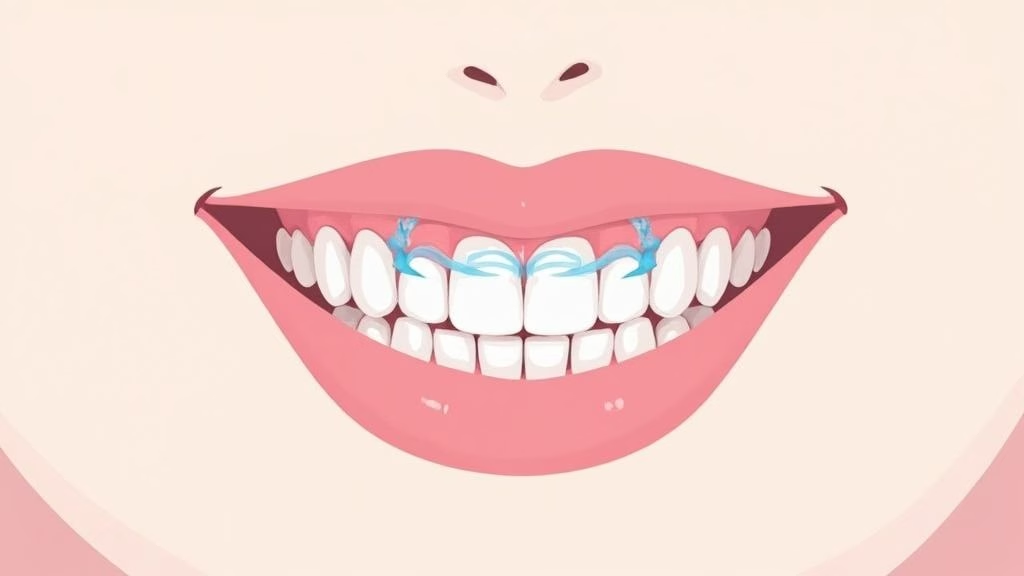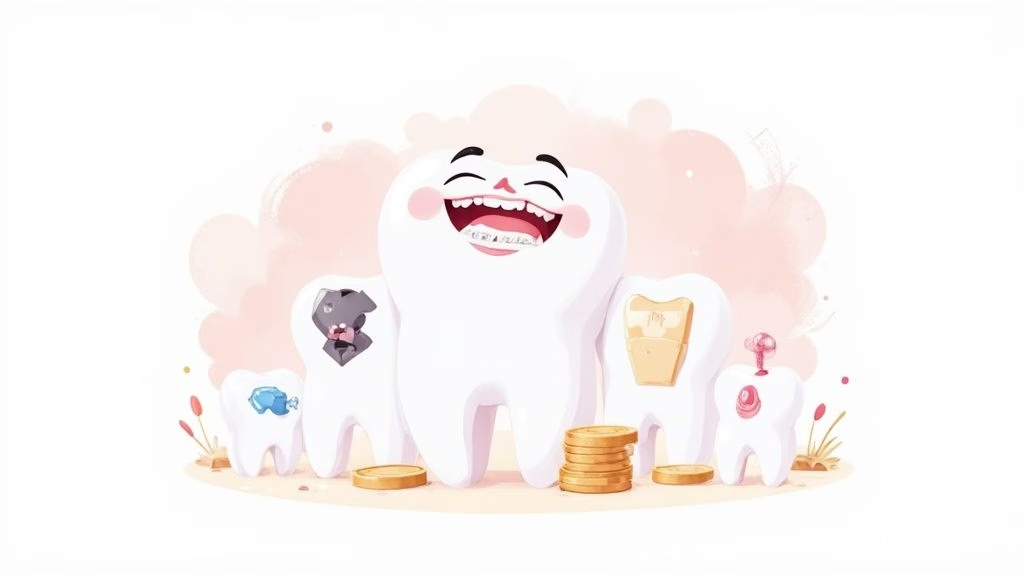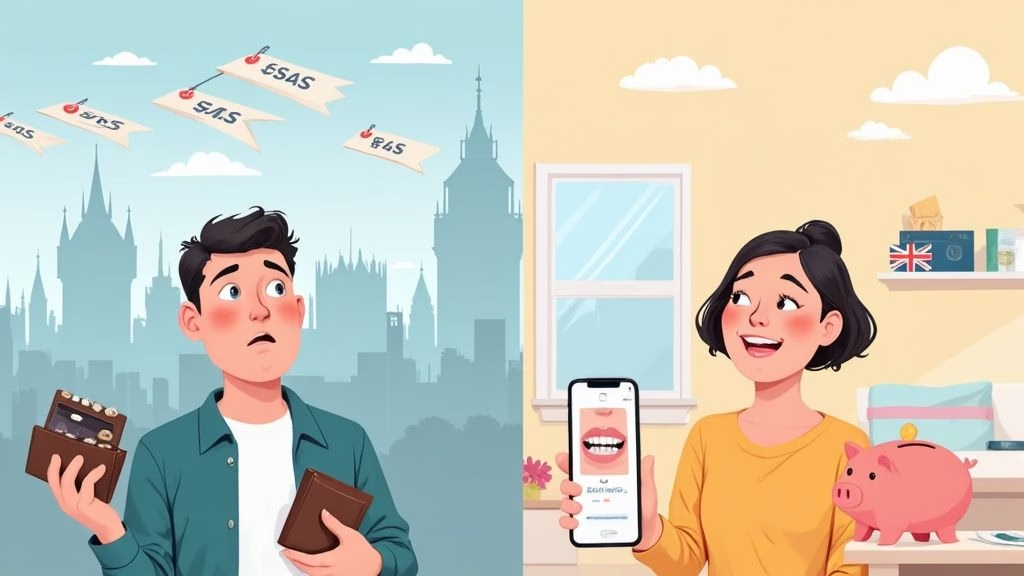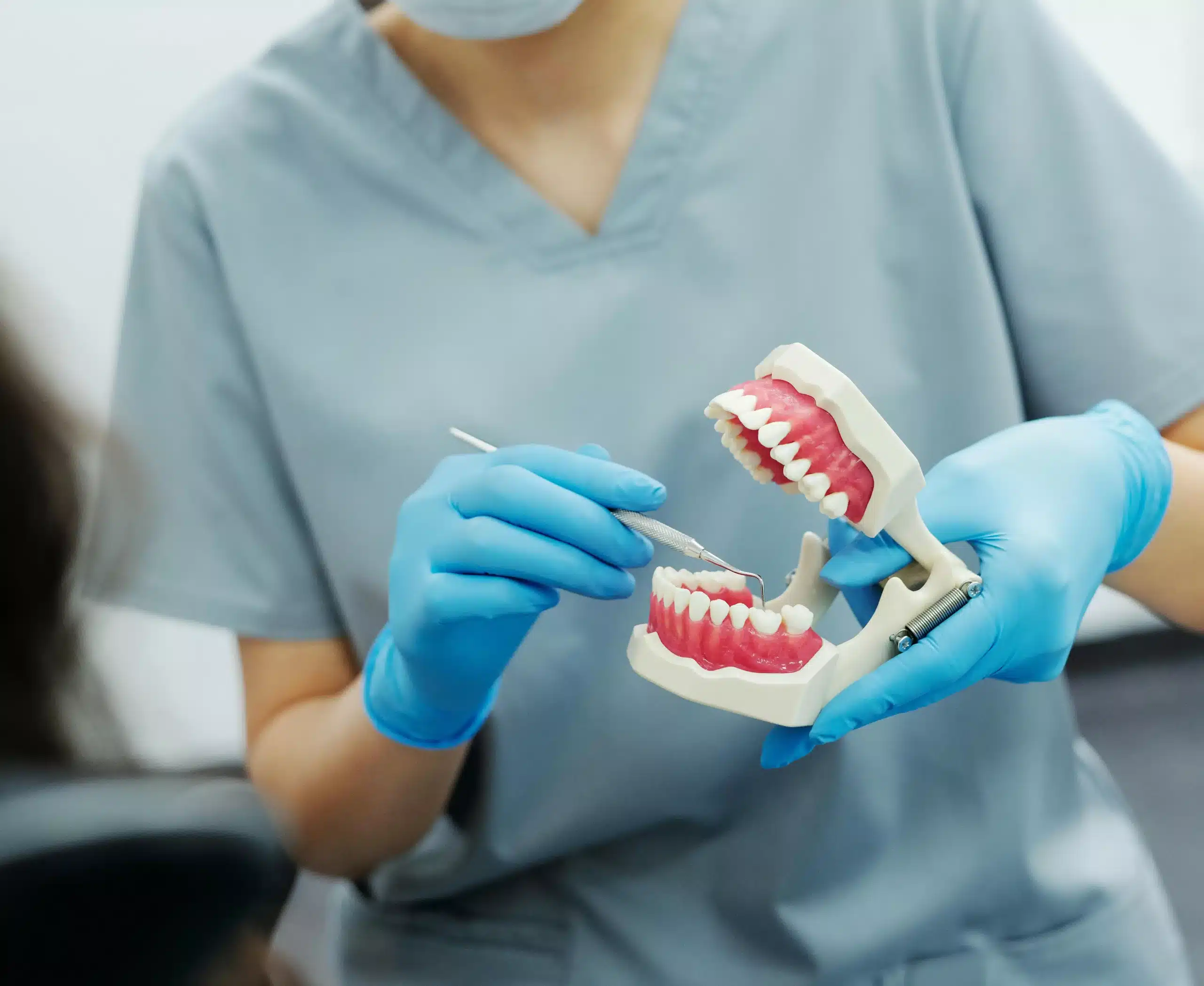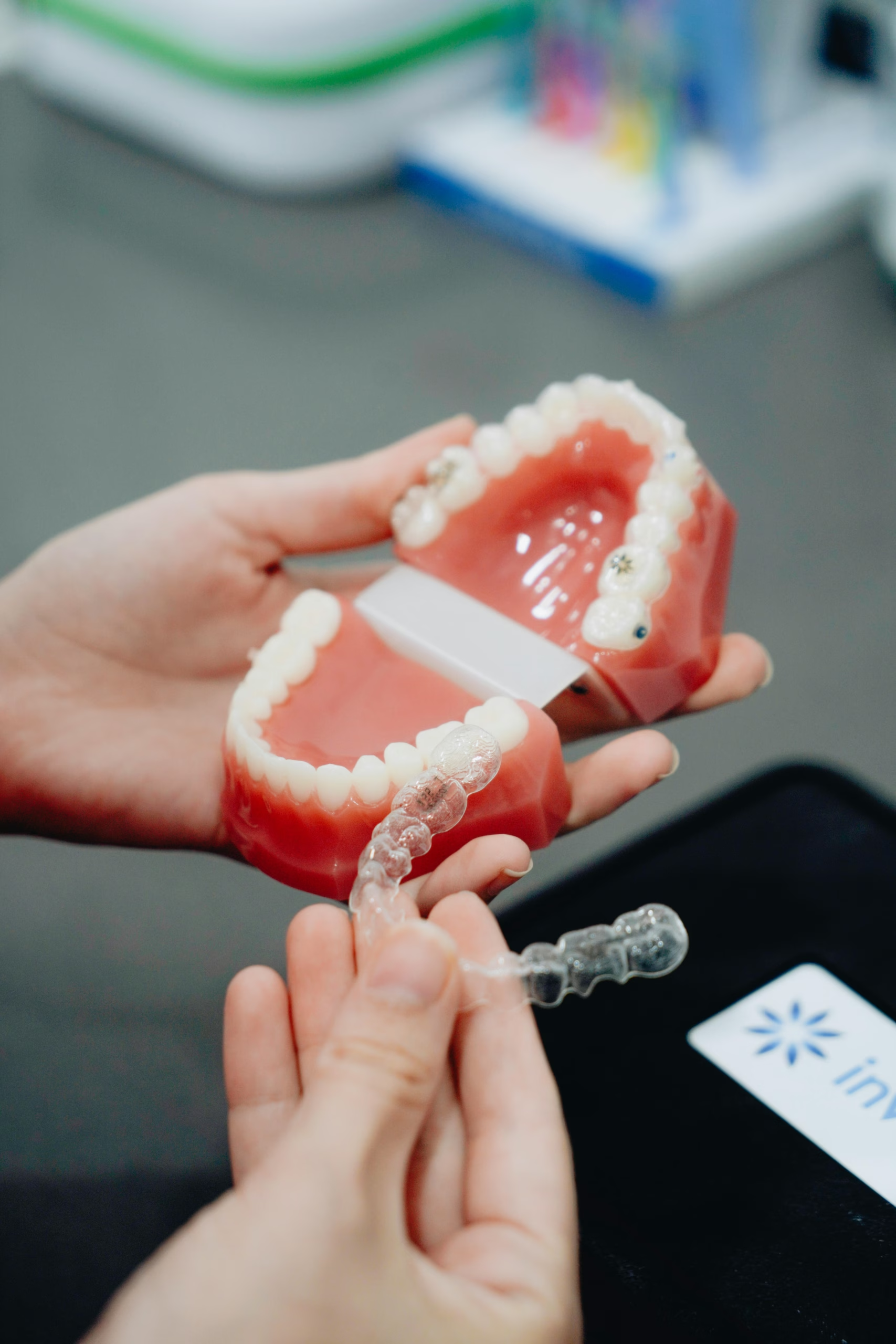What Causes Teeth Staining and How to Fix It
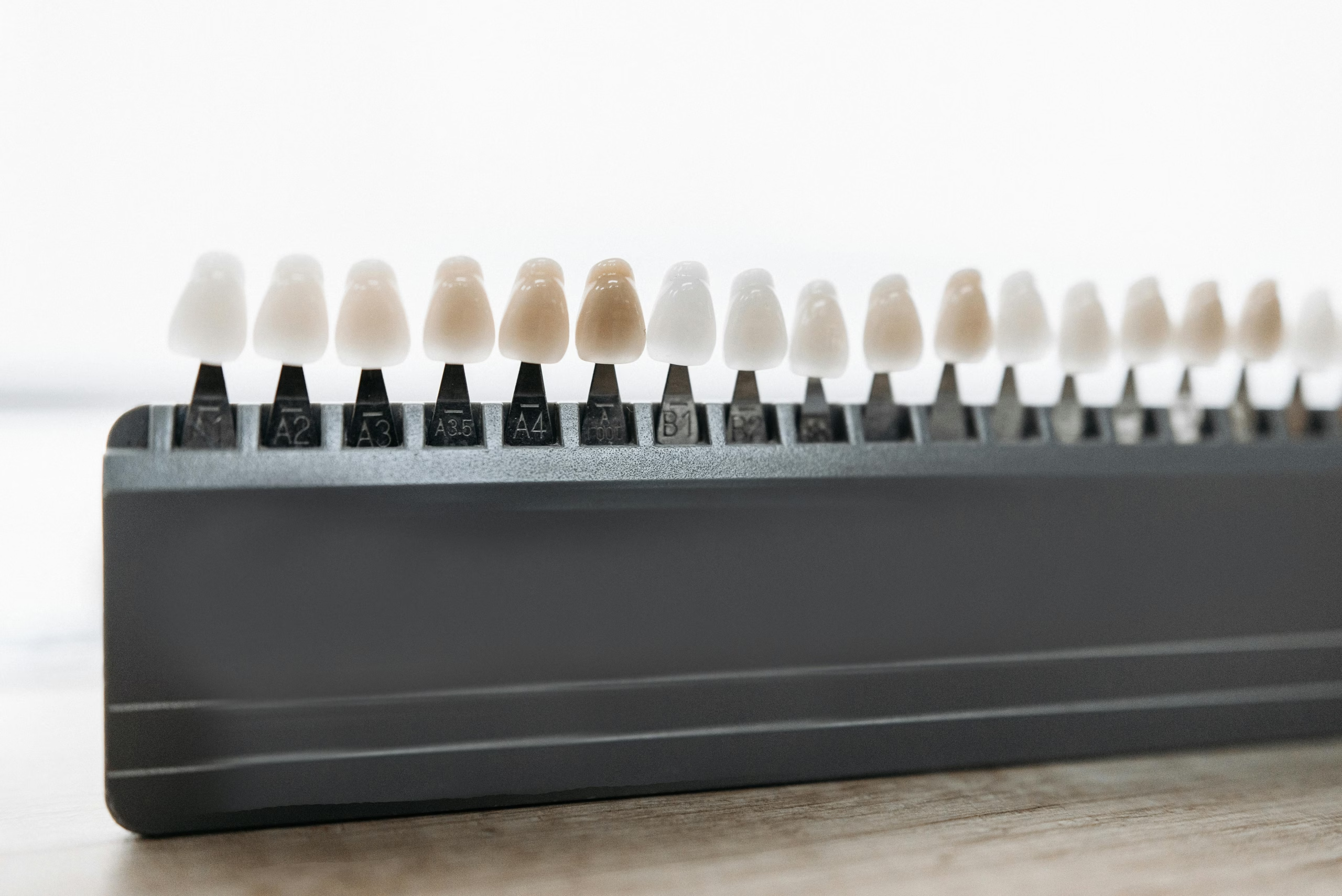
Ever looked in the mirror and wondered why your smile isn’t quite as bright as it used to be? It’s a common thought, and the answer almost always comes down to one of two things: stains on the surface or discolouration coming from deep within the tooth.
Getting to grips with this difference—extrinsic versus intrinsic staining—is the first real step towards getting that brighter smile back.
Your Guide to Understanding Tooth Discolouration
The culprit behind a less-than-white smile isn’t just one thing. It’s usually a mix of factors that fall into those two main camps.
Let’s use an analogy. Think of your tooth enamel as a crisp white t-shirt. Extrinsic stains are like spilling coffee or red wine on it. The stain is on the surface, and with the right approach—like a good wash—you can often get it out.
Now, intrinsic stains are different. Imagine that same t-shirt was made from thread that was dyed grey from the very beginning. The colour is part of the fabric itself, making it much harder to change. These stains start inside the tooth, often because of things like medication, an injury, or even factors from when your teeth were developing.
Surface Stains vs Deep Discolouration
For most of us, it’s the surface stains from our daily lives that are the main issue. Colourful molecules in our food and drink, called chromogens, are the big players here. They stick to our tooth enamel and, over time, build up, leaving behind a yellow or brownish tinge.
Intrinsic discolouration, while less frequent, is a tougher nut to crack. This happens when the dentin—the sensitive layer just under your enamel—darkens or yellows. Because enamel is semi-translucent, this darker colour from inside shows right through, changing the overall shade of your smile. Tackling these deeper stains almost always requires a trip to the dentist.
This chart gives you a clear visual breakdown of how these two types of discolouration work.
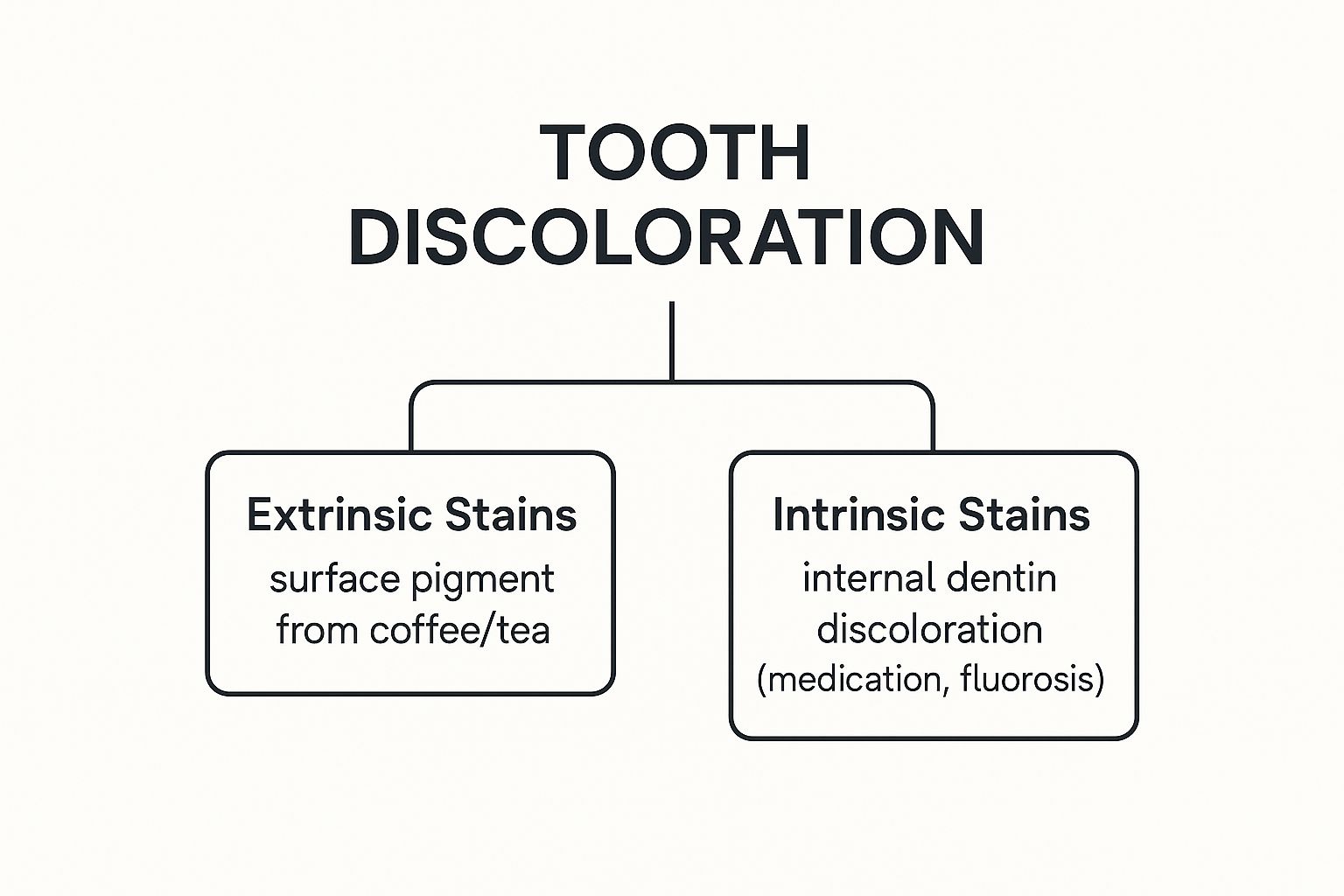
As you can see, it really boils down to whether the problem is on the surface, caused by external things, or a more fundamental issue within the tooth’s structure.
It’s a surprisingly common concern. A UK national study found that around half of all adults felt their teeth were discoloured. The research also highlighted that smokers were far more likely to see their teeth as stained. You can dive into the full research on these self-perception findings yourself.
To make things even clearer, here’s a quick rundown of the usual suspects behind tooth discolouration.
Common Culprits of Tooth Discolouration at a Glance
| Category | Common Causes | Type of Staining |
|---|---|---|
| Diet | Coffee, tea, red wine, berries, curry, tomato-based sauces | Extrinsic |
| Lifestyle | Smoking, chewing tobacco | Extrinsic |
| Oral Hygiene | Poor brushing and flossing habits are allowing plaque build-up | Extrinsic |
| Medical | Certain antibiotics (like tetracycline), chemotherapy, trauma to a tooth | Intrinsic |
| Ageing | Enamel thinning over time, revealing the naturally yellower dentin | Intrinsic |
| Genetics | Naturally thicker or whiter enamel inherited from parents | Intrinsic |
This table shows just how many different things can affect the colour of our teeth, from the food we eat to factors completely out of our control. Knowing the source is key to finding the right solution.
Extrinsic Stains: The Everyday Culprits
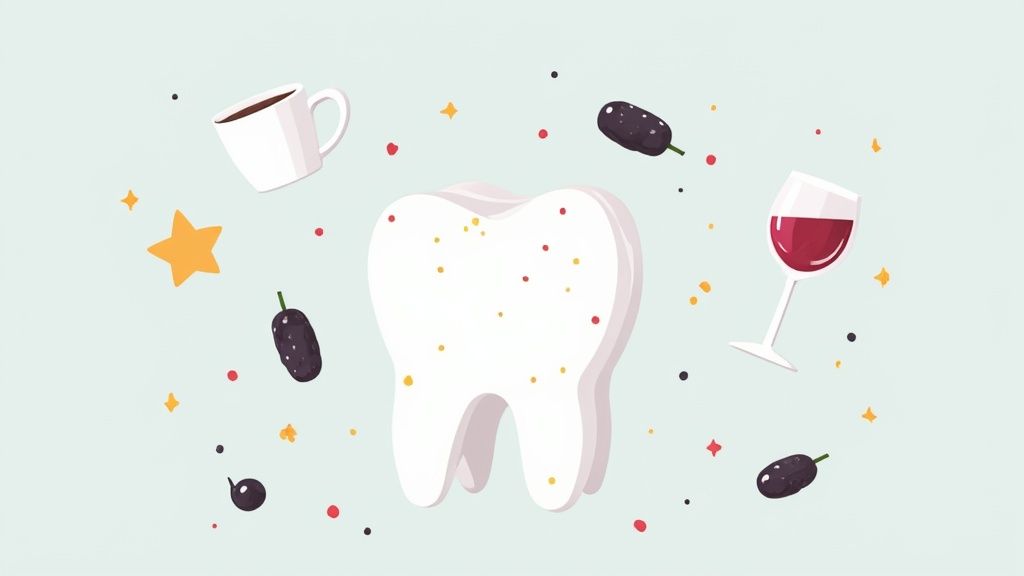
Most of the time, when we talk about teeth staining, we’re dealing with what happens on the surface. These are called extrinsic stains, and they’re the direct result of our day-to-day habits. It helps to think of your tooth enamel less like a solid, smooth shield and more like a surface full of microscopic pits and pores.
Over time, these tiny imperfections act like a sponge, soaking up colouring from everything we eat and drink. It’s the reason that morning cup of coffee or that relaxing glass of red wine can leave a mark long after the last sip.
The Science Behind Surface Stains
So, what’s actually happening on a microscopic level? It all boils down to a few key compounds that love to cling to the protein film that naturally covers your tooth enamel.
- Chromogens: These are the big one. They’re intensely coloured molecules found in things like coffee, tea, red wine, and dark berries. They carry the pigment that latches onto your teeth.
- Tannins: Often partners-in-crime with chromogens, tannins are plant compounds found in tea and wine. Their job is to make it much easier for those colourful stains to stick around.
- Acids: Anything high in acid, like citrus fruits and fizzy drinks, can temporarily soften and roughen your enamel. This essentially creates a better, grippier surface for chromogens and tannins to grab onto.
A recent study really brought home how much our lifestyle affects tooth colour here in the UK. It turns out Londoners have the highest rate of staining, which isn’t surprising when you learn they get through around 77 million cups of coffee and 128 million cups of tea every single week. When you add in other habits, it paints a very clear picture of the link between what we consume and how bright our smiles are. You can read more about these UK city findings for the full breakdown.
And we can’t forget smoking. The nicotine and tar are particularly aggressive, seeping deep into the enamel’s pores. This leads to a stubborn yellow or even brownish discolouration that’s notoriously difficult to shift compared to food and drink stains.
Getting to grips with these everyday culprits is the first real step towards keeping new stains at bay and dealing with the ones you already have. While a professional clean is brilliant for getting rid of this build-up, simply being mindful of your daily habits can make a massive difference in keeping your smile bright.
Intrinsic Stains: When the Discolouration Comes From Within
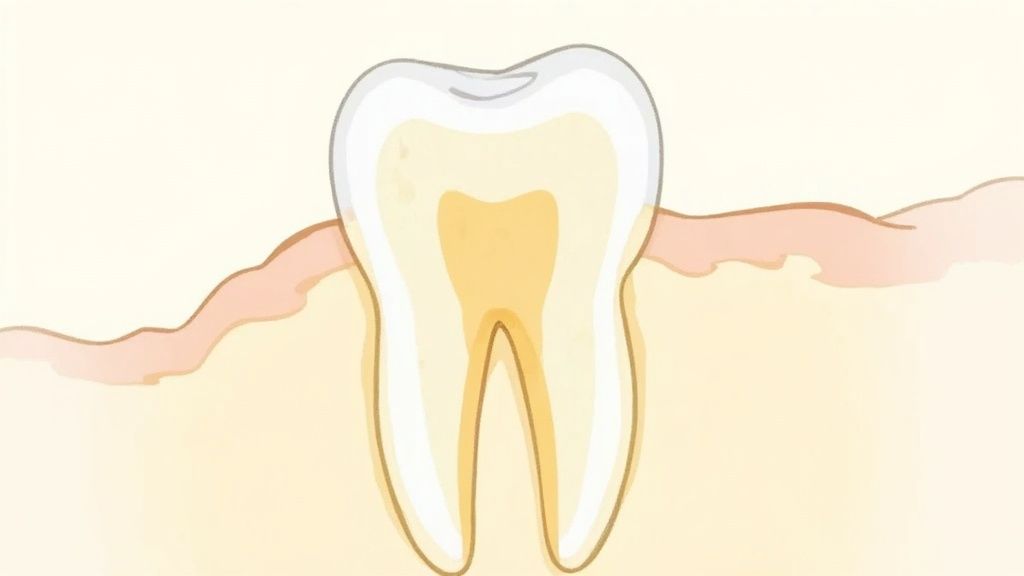
We often blame coffee, tea, and red wine for a less-than-brilliant smile, but sometimes the problem lies much deeper. In these cases, the discolouration isn’t on the surface at all—it’s actually coming from inside the tooth itself.
This is what we call intrinsic staining. It affects the dentin, which is the sensitive, naturally yellowish tissue that sits just underneath your tooth enamel. Because your enamel is semi-translucent, any change in the colour of the dentin will show right through.
This explains why even the most powerful whitening toothpastes and vigorous brushing routines won’t make a difference. You can’t scrub away a stain that’s part of the tooth’s internal structure.
What Causes These Deeper Stains?
Intrinsic discolouration is a different beast altogether. It often develops over many years and can be linked to your health history, medication, or even an old injury. These stains are far tougher to tackle than the everyday extrinsic ones.
Let’s break down the main culprits:
- Trauma or Injury: A hard knock to a tooth, maybe from a childhood accident or a sports injury, can damage the nerve and blood vessels inside. This can cause the tooth to effectively “die,” leading it to darken over time to a grey, pinkish, or even black shade.
- Certain Medications: Some antibiotics, especially tetracycline, are notorious for causing deep, greyish-brown stains if taken by children whose teeth are still developing.
- Too Much Fluoride: While fluoride is a champion at fighting cavities, overexposure during childhood can cause a condition called fluorosis. This usually shows up as faint white lines or chalky patches on the enamel.
It might surprise you just how common these developmental issues are. A national survey of Year 6 children in England found that 13.3% showed signs of conditions like fluorosis that affect tooth colour from an early age. You can dive into the specifics by reading the government’s full report on oral health findings in children.
Ageing is another major factor. As we get older, our protective enamel layer naturally thins out. This erosion allows the yellower dentin underneath to become more prominent, resulting in a smile that looks duller or more yellow. It’s this one-two punch of thinning enamel and changing dentin that explains why our teeth tend to lose their youthful brightness over time, no matter how carefully we look after them.
Your Smile’s Blueprint: Age and Genetics
While we often focus on what we eat and drink, some of the biggest factors influencing your tooth colour are completely out of your hands. Your genetic code, for example, sets the foundation for your smile’s natural brightness right from the start.
Think of it this way: just as your genes decide your eye or hair colour, they also dictate the inherent shade and thickness of your tooth enamel. Some of us are simply born with thicker, whiter enamel, giving us a head start on a bright smile. Others might naturally have thinner enamel, which allows the yellowish dentin layer underneath to peek through more easily.
The Unavoidable Effects of Ageing
As we get older, two key things happen that almost always lead to a less vibrant smile. It’s a natural process that combines both surface-level (extrinsic) and internal (intrinsic) staining factors.
First, a lifetime of chewing and exposure to acidic foods gradually wears down the enamel, making it thinner. At the same time, the dentin lying just beneath the enamel continues to grow and, as part of its natural lifecycle, darkens in colour.
This double-whammy is why teeth tend to look more yellow as we age, even if we’ve been meticulous with our oral hygiene. The thinner enamel just can’t hide the darker dentin below, leading to a noticeable shift in your smile’s overall shade.
When Health and Treatments Leave a Mark
Beyond your DNA and the calendar, your medical history can also play a role in tooth discolouration. Certain health conditions and treatments are known to cause deep, intrinsic staining that typical whitening products can’t touch.
Here are a few common examples:
- Chemotherapy and radiation, particularly around the head and neck, can alter enamel development and its colour.
- Certain infections during pregnancy can impact the developing teeth of the baby, leading to discolouration.
- Rare genetic conditions like dentinogenesis imperfecta and amelogenesis imperfecta cause the enamel and dentin to form improperly, resulting in significant discolouration.
If you’re facing stubborn discolouration—whether from age, genetics, or a medical issue—don’t lose hope. Modern cosmetic dentistry offers fantastic solutions, from professional whitening to creating a healthier, more uniform smile. For many people, achieving a straighter smile with Toothfairy is a smarter, more affordable first move toward a complete smile makeover.
Practical Ways to Prevent Stains and Whiten Teeth
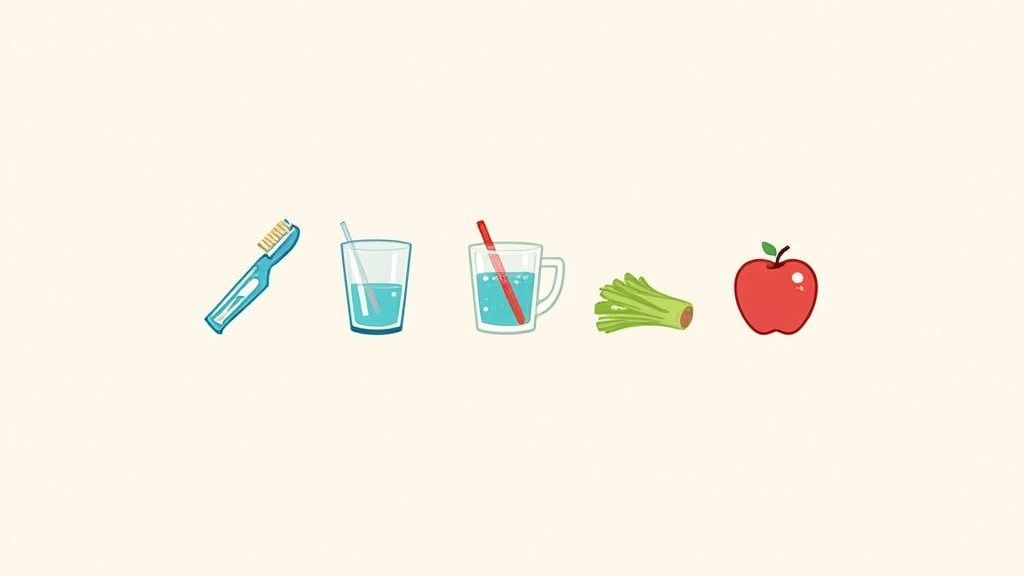
Knowing what causes teeth to stain is one thing, but putting that knowledge into practice is where you’ll see a real difference. The good news is you don’t need to completely change your life to keep surface stains at bay. It’s the small, consistent habits that truly add up to a brighter smile over time.
One of the easiest tricks in the book? Swish your mouth with water right after that cup of coffee, tea, or glass of red wine. This simple rinse washes away those colour-rich compounds before they get a chance to cling to your enamel. If you’re drinking dark sodas or fruit juices, try using a straw—it helps the liquid bypass your front teeth, minimising contact.
Everyday Habits for a Brighter Smile
Beyond these quick fixes, your daily oral hygiene routine is your first and best line of defence. A solid brushing and flossing habit is absolutely non-negotiable. It removes the plaque that stains love to stick to, giving them less of a foothold.
Your diet can also be a surprisingly powerful tool. Think of certain foods as nature’s toothbrushes, helping to scrub your teeth clean while you chew.
- Apples and Celery: Their crunchy, fibrous texture gets your saliva flowing and can physically rub away light surface stains.
- Carrots: Just like apples, that satisfying crunch helps to clean your teeth and gums.
- Dairy Products: Foods like cheese and yoghurt contain lactic acid, which can help strengthen your enamel and protect against decay.
Of course, nothing replaces professional care. Regular check-ups and cleanings with your hygienist are crucial for tackling the stubborn tartar and deep-set surface stains that even the most diligent at-home routine will miss. This is the bridge between what you do every day and what cosmetic treatments can achieve.
For anyone wanting to take things a step further, the route to a whiter smile is more accessible than ever. While prevention is fantastic, modern dentistry has brilliant solutions for existing discolouration. At Toothfairy, we specialise in affordable cosmetic dental work, guiding you to treatments that really work. It’s often the perfect finishing touch after straightening your teeth with clear aligners for a complete smile makeover.
How Modern Dentistry Can Give You Your Brightest Smile
Let’s be realistic—sometimes, even the best daily habits can’t tackle stubborn stains. When prevention and at-home kits just aren’t cutting it, modern cosmetic dentistry has some fantastic and surprisingly accessible options. For that deep-set discolouration, professional teeth whitening is the safest and most effective way to get the noticeable results you’re after.
At Toothfairy, our whole approach is built around making professional cosmetic treatments fit easily into your life, without the hefty price tag. Our dentists will walk you through whitening treatments that are designed to gently lift stains, giving you a brighter smile without the risks or guesswork that come with shop-bought products. We make sure any treatment is right for you and that your oral health is always the top priority.
Thinking Beyond Whitening: The Complete Smile Transformation
Often, the smile you’re dreaming of involves a little more than just changing the colour. Whitening is a brilliant first step, but for a truly head-turning transformation, it often works best as part of a full smile makeover, which might include straightening your teeth as well.
It’s a simple fact: straighter teeth aren’t just for looks. They’re far easier to keep clean, which is your best defence against future staining. When you pair professional whitening with modern clear aligners, you get a smile that’s not only brilliantly white but also beautifully straight.
This combined approach tackles both colour and alignment for a truly polished result. With Toothfairy, you can straighten your teeth discreetly using clear aligners—a much smarter and more affordable option than other aligner brands. By connecting the causes of teeth staining to our clear-cut solutions, we put you firmly in control of your smile journey, from the first step to the final reveal.
Got Questions About Teeth Staining? We’ve Got Answers
We’ve covered a lot of ground, from the foods that stain your teeth to the role genetics plays. It’s only natural to have a few questions. Here are some straightforward answers to the things we get asked most often.
Can Stained Teeth Ever Be White Again?
That really boils down to what kind of stain we’re dealing with. Think of it like a stain on a shirt – some come right out in the wash, while others are there for good.
Extrinsic stains are the ones on the surface, caused by things like coffee, red wine, or smoking. These are often the easiest to tackle. A good professional cleaning, followed by a whitening treatment, can usually lift these stains away, sometimes completely.
Intrinsic stains, on the other hand, are much deeper, originating from inside the tooth itself. This could be due to certain medications, a childhood injury to the tooth, or simply your genetics. These stains won’t respond to whitening, but they can be expertly covered with cosmetic treatments like veneers or bonding, giving you a beautiful, bright smile.
Does Drinking Through a Straw Really Prevent Stains?
Surprisingly, yes! It’s a simple little trick that genuinely helps. When you use a straw, you’re essentially creating a bypass for staining liquids like coffee, tea, and dark sodas.
The liquid goes straight to the back of your mouth, minimising contact with the front surfaces of your teeth. It won’t stop staining altogether, but it can make a noticeable difference in keeping new surface stains from setting in.
Is Professional Whitening Actually Safe for My Teeth?
Yes, absolutely – as long as it’s done under the care of a dental professional. A good dentist won’t just hand you a whitening kit; they’ll first check the health of your teeth and gums to make sure it’s the right and safe option for you.
This professional oversight is what sets it apart from over-the-counter products. Your dentist can tailor the treatment to your specific needs, which dramatically reduces the risk of common issues like tooth sensitivity or gum irritation. It’s the safest and most effective way to brighten your smile.
Ready to take the next step towards a brighter, healthier smile? At Toothfairy, we make expert cosmetic and emergency dental care more affordable and accessible than ever. Start your smile journey today.
Last updated on October 13, 2025

Toothfairy Care Team
Toothfairy, is the world's smartest dental app, that connects patients to a dentist for a range of issues, from emergencies, cosmetics, prescriptions to virtual exams.
Toothfairy Care Team
Toothfairy, is the world's smartest dental app, that connects patients to a dentist for a range of issues, from emergencies, cosmetics, prescriptions to virtual exams.
